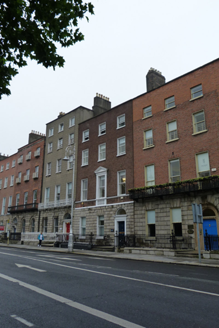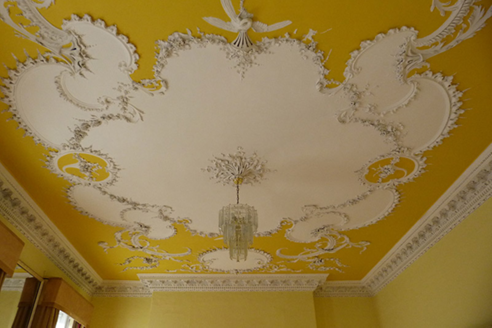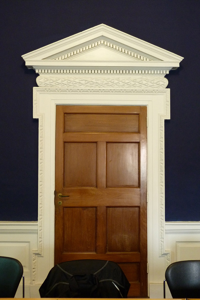Survey Data
Reg No
50100373
Rating
National
Categories of Special Interest
Architectural, Artistic
Original Use
House
In Use As
College
Date
1765 - 1770
Coordinates
316786, 233616
Date Recorded
18/08/2016
Date Updated
--/--/--
Description
Attached three-bay four-storey former house over basement, built c. 1766, having semi-circular bow to western bays of rear with single-storey addition to rear of same and single and two-storey additions to east bay. Now in use as offices. Slate roof, pitched to front part, behind brick parapet with granite coping, half-conical roof to rear bow and hipped roof to east shared with No. 27. Rendered chimneystacks to party walls with clay pots; cast-iron rainwater goods to west. Flemish bond brown brick walls with painted granite coping above ground floor, moulded sill course to first floor, rusticated granite walls to ground floor over granite plinth course and with rendered walls to basement; brick walling to rear. Square-headed window openings, diminishing in height to upper floors, with patent reveals and painted granite sills to first floor and upwards; granite reveals, voussoirs and sills to ground floor, and with round-headed window to ground floor of bow. Replacement one-over-one pane timber sliding sash windows to ground floor and upwards to front elevation and to ground and first floors of rear, replacement casement windows with shutters to basement, and two-over-two pane windows to top two floors of rear. Painted masonry surround to central first floor window with balustraded apron, and pediment supported on brackets. Round-headed door opening with painted moulded granite surround and cornice, plain fanlight and ten-panel timber door with brass door furniture. Granite platform with remnant cast-iron boot-scrape and two granite steps. Wrought-iron railings enclosing basement area with decorative wrought-iron corner post (finial missing) on carved granite plinth. Entrance hall and stairs hall have tiled floors and moulded timber dado rails; entrance hall has heavy ornate plaster cornice, ceiling rose, entrance doorway internally has pilasters, frieze with triglyphs and modillioned cornice, and round-headed doorway to ground floor room with pilasters; stairs hall has timber open-string staircase with turned balusters and ramped mahogany handrail; return has round-headed doorway with Ionic columns, decorative archivolt, margined glazed timber double-leaf door and overlight; square-headed door opening to landing with lugged-and-kneed architrave, timber panelled door and Rococo plasterwork to over-door; ground floor rooms have deep timber skirtings, shallow plaster cornices, lugged-and-kneed surrounds to window openings, chimneypieces to west wall; first floor rooms have deep timber skirtings, timber panelling below chair rail, marble chimneypieces to west wall, timber lugged-and-kneed architraves to timber panelled doors, panelled shutters and window backs to windows; Rococo plasterwork ceiling with dentillated cornice to front room; swagged cornice to rear room. Rear of plot has carparking, recent three-storey brick-faced block with forecourt and brick boundary wall all shared with No. 27.
Appraisal
No. 26 Merrion Square was built in 1766 by John Wilson and sold to Thomas Vesey, 2nd Lord Knapton in 1772. The composition of the façade is unusual, the only one on the square composed in this manner, with its two stringcourses and central pedimented window with architrave and balustrade, providing a strong visual focal point. The work of a skilled mason is evident in the well-executed granite rustication to the ground floor. The interior boasts superb Rococo plasterwork that Casey (2005) suggests may be attributable to the noted stuccodore, Bartholomew Cramillion. No. 26 makes an exceptional contribution to the early character of the square, which has been well retained along this northern stretch. No. 26 was built as part of the original development of the Georgian square. Laid out as part of the Fitzwilliam Estate, Merrion Square is one of the best-preserved Georgian streetscapes in Ireland. The north, east and south sides of the square are lined with terraced houses of eighteenth and nineteenth-century date while the west side is terminated by the garden front of Leinster House. The houses maintain a relatively uniform building height and design, attributed to standards promoted in Fitzwilliam's leases. Individuality was introduced through the design of doorcases, ironwork and interior decorative schemes.





























